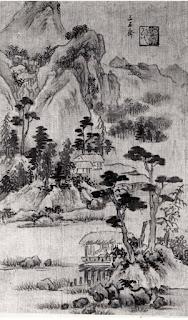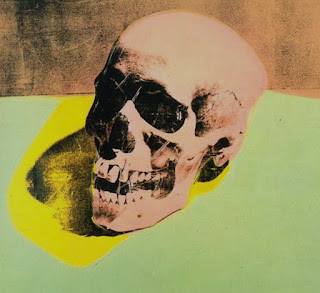Joseon dynasty was the last and longest-lived imperial dynasty in Korea. It started in 1392 and lasted till 1910. It was founded by Gen. Yi Seung-Gye, who established the capital at Hanyang, today we call that Seoul. The kingdom was named Joseon for the state of the same name that had dominated the Korean Peninsula in ancient times.
 |
“Scholar in a Lakeside Pavilion “ by Samoje
|
The first piece I picked is titled “
Scholar in a Lakeside Pavilion” by Samoje. Samoje is the style of a Joseon-period artist. I wasn’t able to find his name. There were two very similar paintings by the artist. Both were done in black and white and is done by a hanging scroll. I like that it’s done in black and white and can be hard to read.
 |
| “Small Landscape and Figures” by Lee Kyoung-yun, Joseon Dynasty, 16th century |
Lee Kyoung-yun created nine pieces of work in the 16th century and kept them in one album with twenty-one sides. It’s currently at the Horim Museum in Korea. It appears to be done on some burlap material. The main focus is of an older man and a young child. It reminds me more of someone doodling in notebook. I enjoy the aspect that it looks like it’s been done in pencil but it’s actually done in paint. I wish I was able to read what’s written on the sides. I personally wouldn’t own a copy but I can see why it’s popular.
 |
| “ Songhahanyudo (Painting of the Rest under a Pine Tree)” by Hu bing |
Hu Bing painted a portrait of Gim Yuk and tilted it “ Songhahanyudo ( Painting of the Rest under a Pine Tree) “ in 1637. It’s currently in the Museum of Silhak. This is another example of a scroll painting. Bing painted Yuk looking relaxed under a pine tree in a robe that I’d assume is silk. I like how he used muted colors that look similar to each other but used a small amount of blue to make him standout. I’ve come to the conclusion that I’m not the biggest fan of the art that came from this period.
Korean, Samoje. “Samoje: Scholar in a Lakeside Pavilion: Korea: Joseon Dynasty (1392–1910).” The Metropolitan Museum of Art, www.metmuseum.org/art/collection/search/40432#:~:text=Samoje%20Korean,jungin%20(middle%20people)%20class. Accessed 25 Apr. 2024.
“Songhahanyudo (Painting of the Rest under a Pine Tree) - Hu Bing - Google Arts & Culture.” Google, Google, artsandculture.google.com/asset/songhahanyudo-painting-of-the-rest-under-a-pine-tree-hu-bing/wAHNuT_i9DMzNA?hl=en. Accessed 25 Apr. 2024.





Hello Kelsey! It's good to see that even though our class apparently has a Japanese preference, there's still some recognition for their westerly neighbors. I think it's cool how Korean scroll paintings mastered that minimalist gradient shading that so nicely portrays the landscapes that the style is known for. The second work looks like a storybook, but I understand why you find it a little underwhelming.
ReplyDeleteIt's interesting to think of how the Imperial Korean culture shows through their art, because the man is standing in full silk regalia while supposedly resting. One thing I've noticed is the Korean style does not have a great amount of variation in their human poses, but their depictions of natural wonders are very detailed and exotic.